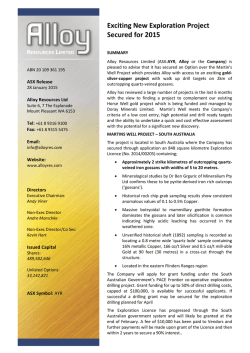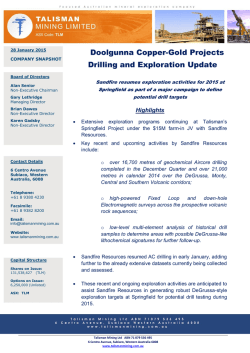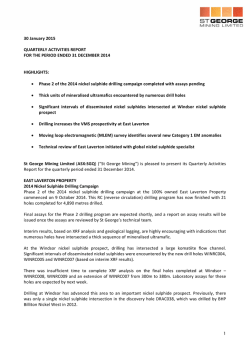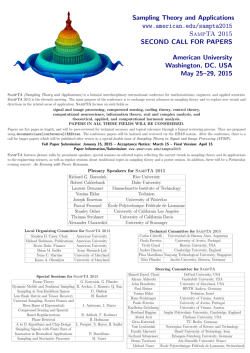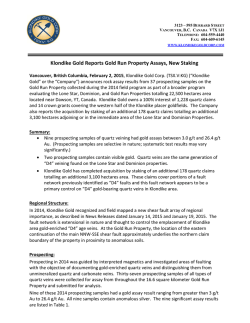
2015 Nickel Exploration Program Starts Strongly
ASX / MEDIA RELEASE 28 January 2015 ST GEORGE’S 2015 NICKEL EXPLORATION PROGRAM STARTS STRONGLY WITH SEVERAL NEW PRIORITY EM TARGETS IDENTIFIED HIGHLIGHTS: Moving loop electromagnetic (MLEM) survey identifies several new Category 1 EM conductors at the Desert Dragon North and Aphrodite nickel sulphide prospects Assays for 2014 drilling at the Windsor nickel sulphide prospect are due next week Technical review of the East Laverton Project is underway by St George exploration team in consultation with leading nickel sulphide specialist The findings of the technical review will assist in prioritising drill targets for 2015 Exploration results to date show a close comparison between the geology at East Laverton and the Agnew‐Wiluna nickel belt Drilling campaign planned to re‐commence in late February 2015 NEW CATEGORY 1 EM CONDUCTORS St George Mining Limited (ASX: SGQ) (‘St George Mining’ or ‘the Company’) is pleased to announce that several new high quality EM conductors have been identified at the Desert Dragon North and Aphrodite nickel sulphide prospects by the ongoing MLEM survey at the Company’s 100% owned East Laverton Property in Western Australia. The MLEM survey is arranged by Newexco, the Company’s geophysical advisers, who have also provided an interpretation of the geophysical properties of the EM anomalies identified. At Desert Dragon North, 13 EM anomalies consistent with bedrock anomalies were identified. Four of these have been classified by Newexco as Category 1 anomalies. At Aphrodite, 4 EM anomalies were identified with two of these being rated by Newexco as Category 1 anomalies. Category 1 anomalies are well defined EM anomalies which demonstrate all the primary criteria for a massive sulphide body and warrant immediate consideration as drill targets. John Prineas, Executive Chairman of St George Mining said: “The new EM anomalies are a great addition to our large pipeline of nickel sulphide targets. This underscores our tremendous exploration upside and our potential to establish a new nickel camp. “Our exploration team is now reviewing the new EM anomalies in the context of the available geochemical, geological and structural data so we can prioritise the targets for drill testing. “We are working towards resuming our drill program by late February, and we expect to have a number of outstanding drill targets with excellent prospectivity for massive nickel sulphide mineralisation.” 1 ASX / MEDIA RELEASE Further details regarding the new EM conductors will be announced once the review of these anomalies by St George’s technical team is completed. In addition, data from the MLEM survey completed at several other nickel sulphide prospects is also being reviewed by St George and we anticipate a number of further high quality drill targets to be defined at these prospects once this data is assessed. TECHNICAL REVIEW USING UPDATED DATABASE A substantial amount of new geophysical, geological and drilling data was generated from the exploration activities at the East Laverton Property in 2014. This has provided an opportunity for a strategic technical review of the expanded exploration database. The review will focus on exploration targeting criteria at East Laverton, and is expected to generate new prospects as well as allowing for the prioritisation of the large pipeline of exploration targets at the Project. The St George exploration team is completing this technical review in conjunction with Matthew McCarthy and Dr Jon Hronsky. We expect to complete the review in early February 2015. Mr McCarthy is a geologist with a strong background in komatiite‐hosted nickel exploration in Western Australia. He was previously a Senior Geologist with BHP Billiton Nickel West, where he was part of the team that made the recent discovery of the significant Venus nickel sulphide deposit at Leinster. He also managed the exploration programme under the previous farm‐in arrangement between St George Mining and BHP Billiton Nickel West, which discovered nickel sulphides at East Laverton in 2012. Dr Hronsky is a geologist with over 30 years of experience in mineral exploration, primarily focused on project generation and exploration strategy. His particular expertise is targeting for nickel sulphide deposits and this work has led to a number of discoveries including the West Musgrave nickel sulphide province in Western Australia. Dr Hronsky is one of the principals at geological consultancy firm Western Mining Services (“WMS”). Prior to joining WMS, he was Manager‐Strategy & Generative Services for BHP Billiton Mineral Exploration and before that the Global Geoscience Leader for WMC Resources Ltd. Dr Hronsky is currently Chairman of the Centre for Exploration Targeting in Western Australia and was the 2009 Society of Economic Geology Distinguished Lecturer. John Prineas, Executive Chairman of St George Mining said: “This review will assist us to prioritise our numerous prospects with the aim of delivering exploration success as soon as possible. “Jon Hronsky’s ideas and advice on exploration strategy, an area where he has industry leading credentials, will be of significant value.” 2014 SUCCESSFUL DRILLING ‐ WINDSOR NICKEL SULPHIDE PROSPECT The remaining assays for the recent drilling at the Windsor nickel sulphide prospect are due by next week. The assays relate to drill holes WINRC008, WINRC009 and the extension of WINRC007 from 300m to 380m. The drilling completed in 2014 at the Windsor nickel prospect successfully intersected thick intervals of ultramafic with intervals of high tenor disseminated nickel sulphides. This confirms the overall fertile nature of the komatiite channel at Windsor and the potential for massive nickel sulphide mineralisation. 2 ASX / MEDIA RELEASE Current data indicates that this komatiite channel has a strike length exceeding 300m with an extensive and folded basal contact for the ultramafic rocks. This large and highly prospective surface is mostly untested and offers a substantial exploration opportunity for a nickel sulphide discovery. A report on the 2014 drilling results will be issued once all assays have been received and reviewed by St George’s technical team. EMERGING NICKEL PROVINCE St George continues to systematically explore for nickel sulphide mineralisation at each of the three ultramafic belts at East Laverton. The total strike length of the belts is over 130km. Exploration results at the East Laverton Property have shown close comparisons between the geology at East Laverton and the Agnew‐Wiluna belt. The ultramafic rocks at the Agnew‐Wiluna belt are derived from a rare, magnesium‐rich parental magma and drilling by St George and BHP Billiton Nickel West (under the concluded Project Dragon farm‐in arrangement) has shown that these highly favourable ultramafic rocks also exist on a large scale at East Laverton. The Agnew‐Wiluna belt is the most significant nickel belt in Western Australia and hosts a number of world class nickel sulphide deposits including Perseverance, Rocky’s Reward, Mt Keith and the Cosmos nickel camp. The similarities between the geology at East Laverton and Agnew‐Wiluna support the potential of the East Laverton Property to emerge as a new nickel province. Figure 1 below shows the numerous high priority prospects at the East Laverton Property. Figure 2 shows the location of our emerging nickel province relative to the Agnew‐Wiluna belt in the NE Goldfields. Figure 1 – the high priority nickel sulphide prospects at the East Laverton Property 3 ASX / MEDIA RELEASE Figure 2 – the East Laverton Property is an emerging nickel province in Western Australia 4 ASX / MEDIA RELEASE For further information, please contact: John Prineas Executive Chairman St George Mining Limited (+61) 411 421 253 [email protected] Colin Hay Professional Public Relations (+61) 08 9388 0944 mob 0404 683 355 [email protected] Competent Person Statement: The information in this report that relates to exploration results is based on information previously compiled by Mr Timothy Hronsky, a Competent Person who is a Member of The Australasian Institute of Mining and Metallurgy. Mr Hronsky is employed by Essential Risk Solutions Ltd which has been retained by St George Mining Limited to provide technical advice on mineral projects. Mr Hronsky has sufficient experience that is relevant to the style of mineralisation and type of deposit under consideration and to the activity being undertaken to qualify as a Competent Person as defined in the 2012 Edition of the ‘Australasian Code for Reporting of Exploration Results, Mineral Resources and Ore Reserves’. Mr Hronsky consents to the inclusion in the report of the matters based on his information in the form and context in which it appears. The information in this announcement that relates to Exploration Results and Mineral Resources as defined in the 2004 edition of the ‘Australasian Code for Reporting of Exploration Results, Mineral Resources and Ore Reserves’ is based on information compiled by Mr Hronsky. Mr Hronsky is a member of the Australasian Institute of Mining and Metallurgy has sufficient experience, which is relevant to the style of mineralisation and type of deposit under consideration and to the activity, which he is undertaking. This qualifies Mr Hronsky as a “Competent Person” as defined in the 2004 edition of the ‘Australasian Code for Reporting of Exploration Results, Mineral Resources and Ore Reserves’. Mr Hronsky consents to the inclusion of information in this announcement in the form and context in which it appears. 5 The following sections are provided for compliance with requirements for the reporting of exploration results under the JORC Code, 2012 Edition. Section 1 Sampling Techniques and Data (Criteria in this section apply to all succeeding sections) Criteria JORC Code explanation Commentary Sampling techniques Nature and quality of sampling (eg cut channels, random chips, or specific specialised industry standard measurement tools appropriate to the minerals under investigation, such as down hole gamma sondes, or handheld XRF instruments, etc). These examples should not be taken as limiting the broad meaning of sampling. This ASX Release dated 28 January 2015 reports on the results of a moving loop electromagnetic (MLEM) survey being carried out at the Company’s East Laverton Property in the NE Goldfields, as well as fixed loop electromagnetic (FLEM) surveys over specific conductors identified by the MLEM. The ASX Release does not report any new drilling, assay or other sampling exploration work. The MLEM and FLEM surveys are designed and managed by Newexco, with field work contracted to Bushgum Pty Ltd. Key specifications of the MLEM survey are: Stations Spacing: 100m Loop: 400m, 200m Line Spacing: 400m Components: x y z Orientation: X along line (local east ‐ positive). Line direction: 58.35, 90 degrees Frequency: 0.5, 0.25 Hz Channels: SMARTem Standard. Receiver: Fluxgate Number turns: 1 Current: Typically 50 A. Repeats: Minimum 3 consistent readings per station. The FLEM survey was conducted with two transmit loops, each with two lines of data. Include reference to measures taken to ensure Field calibration of the survey instruments using standards is sample representivity and the appropriate undertaken each day. A minimum of 3 consistent readings per calibration of any measurement tools or station are taken to ensure accuracy of data collected. systems used. Aspects of the determination of mineralisation The ASX Release does not report any drilling or assay sampling that are Material to the Public Report. exploration. In cases where ‘industry standard’ work has been done this would be relatively simple (eg ‘reverse circulation drilling was used to obtain 1 m samples from which 3 kg was pulverised to produce a 30 g charge for fire assay’). In other cases more explanation may be required, such as where there is coarse gold that has inherent sampling problems. Unusual commodities or mineralisation types (eg submarine nodules) may warrant disclosure of detailed information. Drilling techniques Drill type (eg core, reverse circulation, open‐ The ASX Release does not report any drilling or assay sampling hole hammer, rotary air blast, auger, Bangka, exploration. sonic, etc) and details (eg core diameter, triple or standard tube, depth of diamond tails, face‐ sampling bit or other type, whether core is oriented and if so, by what method, etc). 1 Criteria JORC Code explanation Commentary Drill sample recovery Method of recording and assessing core and chip sample recoveries and results assessed. The ASX Release does not report any drilling or assay sampling exploration. The ASX Release does not report any drilling or assay sampling exploration. Measures taken to maximise sample recovery and ensure representative nature of the samples. Whether a relationship exists between sample The ASX Release does not report any drilling or assay sampling recovery and grade and whether sample bias exploration. may have occurred due to preferential loss/gain of fine/coarse material. Logging Whether core and chip samples have been geologically and geotechnically logged to a level of detail to support appropriate Mineral Resource estimation, mining studies and metallurgical studies. The ASX Release does not report any drilling or assay sampling exploration. Whether logging is qualitative or quantitative The ASX Release does not report any drilling or assay sampling in nature. Core (or costean, channel, etc) exploration. photography. Sub‐sampling techniques and sample preparation The total length and percentage of the relevant intersections logged. The ASX Release does not report any drilling or assay sampling exploration. If core, whether cut or sawn and whether quarter, half or all core taken. The ASX Release does not report any drilling or assay sampling exploration. If non‐core, whether riffled, tube sampled, rotary split, etc and whether sampled wet or dry. The ASX Release does not report any drilling or assay sampling exploration. For all sample types, the nature, quality and appropriateness of the sample preparation technique. The ASX Release does not report any drilling or assay sampling exploration. Quality control procedures adopted for all sub‐ sampling stages to maximise representivity of samples. The ASX Release does not report any drilling or assay sampling exploration. Measures taken to ensure that the sampling is representative of the in situ material collected, including for instance results for field duplicate/second‐half sampling. The ASX Release does not report any drilling or assay sampling exploration. Whether sample sizes are appropriate to the grain size of the material being sampled. The ASX Release does not report any drilling or assay sampling exploration. 2 Criteria JORC Code explanation Commentary Quality of assay data and laboratory tests The nature, quality and appropriateness of the assaying and laboratory procedures used and whether the technique is considered partial or total. The ASX Release does not report any drilling or assay sampling exploration. Verification of sampling and assaying For geophysical tools, spectrometers, handheld XRF instruments, etc, the parameters used in determining the analysis including instrument make and model, reading times, calibrations factors applied and their derivation, etc. Specifications for the MLEM/FLEM survey are noted above. Digital data was supplied by Bushgum. The recorded response (μV) was normalised by transmitter current (A) by the SMARTem. B‐field data were converted from μV/A into pT/A by a multiplication factor of 0.35. Nature of quality control procedures adopted (eg standards, blanks, duplicates, external laboratory checks) and whether acceptable levels of accuracy (ie lack of bias) and precision have been established. A minimum of 3 consistent readings per station are taken to ensure accuracy of data collected. Field data was inspected for repeatability and consistent decays. Where multiple recordings were made and differed significantly, the outlying record was deleted using Agent99 and other proprietary software. The verification of significant intersections by The ASX Release does not report any drilling or other sampling either independent or alternative company exploration work. personnel. The use of twinned holes. The ASX Release does not report any drilling or assay sampling exploration. Documentation of primary data, data entry procedures, data verification, data storage (physical and electronic) protocols. The ASX Release does not report any drilling or assay sampling exploration. Discuss any adjustment to assay data. Location of data points Data spacing and distribution The ASX Release does not report any drilling or assay sampling exploration. Accuracy and quality of surveys used to locate The ASX Release does not report any drilling or assay sampling drill holes (collar and down‐hole surveys), exploration. trenches, mine workings and other locations used in Mineral Resource estimation. Specification of the grid system used. Each station for the MLEM survey was located using the GDA94, MGA Zone 51 coordinate system with a GPS programmed with this datum (+/‐ 5m). Stations were located with minimal flagging. Quality and adequacy of topographic control. See above. Data spacing for reporting of Exploration Results. Data readings were taken at stations spaced 100m apart with 400m loops. Where required, infill readings were taken to enhance data collection. Whether the data spacing and distribution is The ASX Release does not report any drilling or assay sampling sufficient to establish the degree of geological exploration. and grade continuity appropriate for the Mineral Resource and Ore Reserve estimation procedure(s) and classifications applied. Orientation of data in relation to geological structure Whether sample compositing has been applied. The ASX Release does not report any drilling or assay sampling exploration. Whether the orientation of sampling achieves unbiased sampling of possible structures and the extent to which this is known, considering the deposit type. The ASX Release does not report any drilling or assay sampling exploration. 3 Criteria JORC Code explanation Commentary If the relationship between the drilling orientation and the orientation of key mineralised structures is considered to have introduced a sampling bias, this should be assessed and reported if material. The ASX Release does not report any drilling or assay sampling exploration. Sample security The measures taken to ensure sample security. The ASX Release does not report any drilling or assay sampling exploration. Audits or reviews The results of any audits or reviews of sampling techniques and data. No detailed audits or reviews have been conducted at this stage. Section 2 Reporting of Exploration Results Criteria JORC Code explanation Commentary Mineral Tenement and Land Status Type, name/reference number, location and ownership including agreements or material issues with third parties including joint ventures, partnerships, overriding royalties, native title interests, historical sites, wilderness or national park and environmental settings. The moving loop electromagnetic (MLEM) survey discussed in this ASX Release has covered areas that are within Exploration Licences E39/1667, E39/1467, E39/1520, E39/1492 and E39/1229 which are part of the Company’s East Laverton Property in the NE Goldfields. Each tenement is 100% owned by Desert Fox Resources Pty Ltd, a wholly owned subsidiary of St George Mining. E39/1492, E39/1229 and E39/1467 are subject to a 2% Net Smelter Royalty in favour of a third party. The security of the tenure held at the time of reporting along with any known impediments None of the tenements are the subject of a native title claim. No to obtaining a licence to operate in the area. environmentally sensitive sites have been identified at any of the tenements. The tenements are in good standing and no known impediments exist. Exploration Done by Other Parties Acknowledgment and appraisal of exploration by other parties. In 2012, BHP Billiton Nickel West Pty Ltd (Nickel West) completed a reconnaissance RC (reverse circulation) drilling programme at certain tenements at the East Laverton Property as part of the Project Dragon farm‐in arrangement between Nickel West and the Company. That farm‐in arrangement has been terminated. The results from the Nickel West drilling programme were reported by the Company in its ASX Release dated 25 October 2012 “Drill Results at Project Dragon”. Drilling intersected primary nickel sulphide mineralisation and established the presence of fertile, high MgO ultramafic sequences at the East Laverton Property. Prior to the Project Dragon drilling programme, there was no systematic exploration for nickel sulphides at the East Laverton Property. Historical exploration in the region was dominated by shallow RAB and aircore drilling, much of which had been incompletely sampled, assayed, and logged. This early work was focused on gold rather than nickel sulphide exploration. Geology Deposit type, geological setting and style of mineralisation The East Laverton Property is located in the NE corner of the Eastern Goldfields Province of the Archean Yilgarn Craton of Western Australia. The project area is proximally located to the Burtville‐Yarmana terrane boundary and the paleo‐cratonic marginal setting is consistent with the extensive komatiites and carbonatite magmatism found on the property. 4 Criteria JORC Code explanation Commentary The area is largely covered by Permian glaciogene sediments (Patterson Formation), which is subsequently overlain by a thinner veneer of more recent sediments and aeolian sands. As a result the geological knowledge of the belt has previously been largely inferred from gravity and magnetic data and locally verified by drill‐ hole information and multi‐element soil geochemical surveys. The drilling at the East Laverton Property has confirmed extensive strike lengths of high‐MgO olivine‐rich rocks across three major ultramafic belts. Ultramafic rocks of this composition are known to host high grade nickel sulphides. Drill hole information A summary of all information material to the understanding of the exploration results including tabulation of the following information for all Material drill holes: • Easting and northing of the drill hole collar •Elevation or RL (Reduced Level – elevation above sea level in meters) of the drill hole collar • Dip and azimuth of the hole • Down hole length and interception depth • Hole length Data aggregation methods In reporting Exploration Results, weighting The ASX Release does not report any drilling or assay sampling averaging techniques, maximum and/or exploration. minimum grade truncations (e.g. cutting of high grades) and cut‐off grades are usually Material and should be stated. This ASX Release relates to electromagnetic surveys currently underway at the East Laverton Property. There are no new drill holes to disclose. Significant intersections from historical holes are listed in the attached Table 1. Drill hole information on historical drill hole DDNRC002 is also found in the Company’s ASX Release dated 11 April 2013 “St George Provides Exploration Update” and which is available to view on www.stgm.com.au. Where aggregated intercepts incorporate short The ASX Release does not report any drilling or assay sampling lengths of high grade results and longer exploration. lengths of low grade results, the procedure used for such aggregation should be stated and some typical examples of such aggregations should be shown in detail. The assumptions used for any reporting of metal equivalent values should be clearly stated. Relationship between mineralisation widths and intercept lengths The ASX Release does not report any drilling or assay sampling exploration. These relationships are particularly important The ASX Release does not report any drilling or assay sampling in the reporting of exploration results. exploration. If the geometry of the mineralisation with respect to the drill hole angle is known, its nature should be reported. If it is not known and only the down hole lengths are reported, there should be a clear statement to this effect (e.g. down hole length, true width not known). Diagrams Appropriate maps and sections (with scales) Relevant maps are included in the body of the ASX Release. and tabulations of intercepts should be included for any significant discovery being reported. These should include, but not be limited to a plane view of drill hole collar locations and appropriate sectional views. Balanced Reporting Where comprehensive reporting of all Exploration Results is not practical, representative reporting of both low and high grades and/or widths should be practiced to avoid misleading reporting Exploration Results. 5 The MLEM survey is ongoing and only interim results can be reported at this stage. Criteria JORC Code explanation Commentary Other substantive exploration data Further Work Other exploration data, if meaningful and material, should be reported including (but not limited to): geological observation; geophysical survey results; geochemical survey results; bulk samples – size and method of treatment; metallurgical test results; bulk density, groundwater, geotechnical and rock characteristics; potential deleterious or contaminating substances. In 2011, a regional, partial‐leach, soil geochemical survey was completed on a staggered 500 m sample grid over a large part of the East Laverton Property. Samples were assayed at the SGS laboratory in Perth using a weak leach and XRF analysis. This identified elevated Ni‐Cu soil values in a number of areas across the East Laverton Property. A regional geochemical survey conducted by the Geological Survey of Western Australia (GSWA) in the area also identified several highly anomalous and coincident Ni‐Cu soil values as reported by the Company in its ASX Release dated 27 September 2012 “St George Accelerates Cambridge Nickel Prospect Exploration” and which is available to view on www.stgm.com.au. All other meaningful and material information has been included in the body of the ASX Release. The nature and scale of planned further work The MLEM survey is ongoing. Drill targets will be selected once the (e.g. tests for lateral extensions or depth survey is completed and EM anomalies are modelled. Further extensions or large – scale step – out drilling). discussion on future exploration is included in the body of the ASX Release. Diagrams clearly highlighting the areas of possible extensions, including the main geological interpretations and future drilling areas, provided this information is not commercially sensitive. HOLE ID NORTHIN G (m) EASTIN G (m) DIP (deg) AZM (deg) DEPT H (m) FROM (m) TO (m) WIDTH (m) Ni (%) Cu (ppm) Pt+Pd (ppb) DRAC35 6739401 527150 ‐60 250 244 100 118 18 0.40 342 197 100 104 4 0.57 366 294 112 114 2 0.51 584 281 DRAC38 6733696 108 138 30 0.31 10 31 132 138 6 0.48 40 48 132 134 2 0.62 92 53 DDNRC002 6742718 53 60 7 0.54 53 55 2 1.08 530786 523717 ‐60 ‐60 250 59 298 246 Table 1 to 2012 JORC Section – Significant intersections in DRAC35, DRAC38 and DDNRC002. These historical holes are the first identification of nickel sulphides at the East Laverton Property. For further details on DRAC35 and DRAC38, see the ASX Release dated 25 October 2012 “Drill Results at Project Dragon”. For further details on DDNRC002, see the ASX Release dated 11 April 2013 “St George Provides Exploration Update”. These ASX Releases are available to view on the Company’s website at www.stgm.om.au 6
© Copyright 2024
